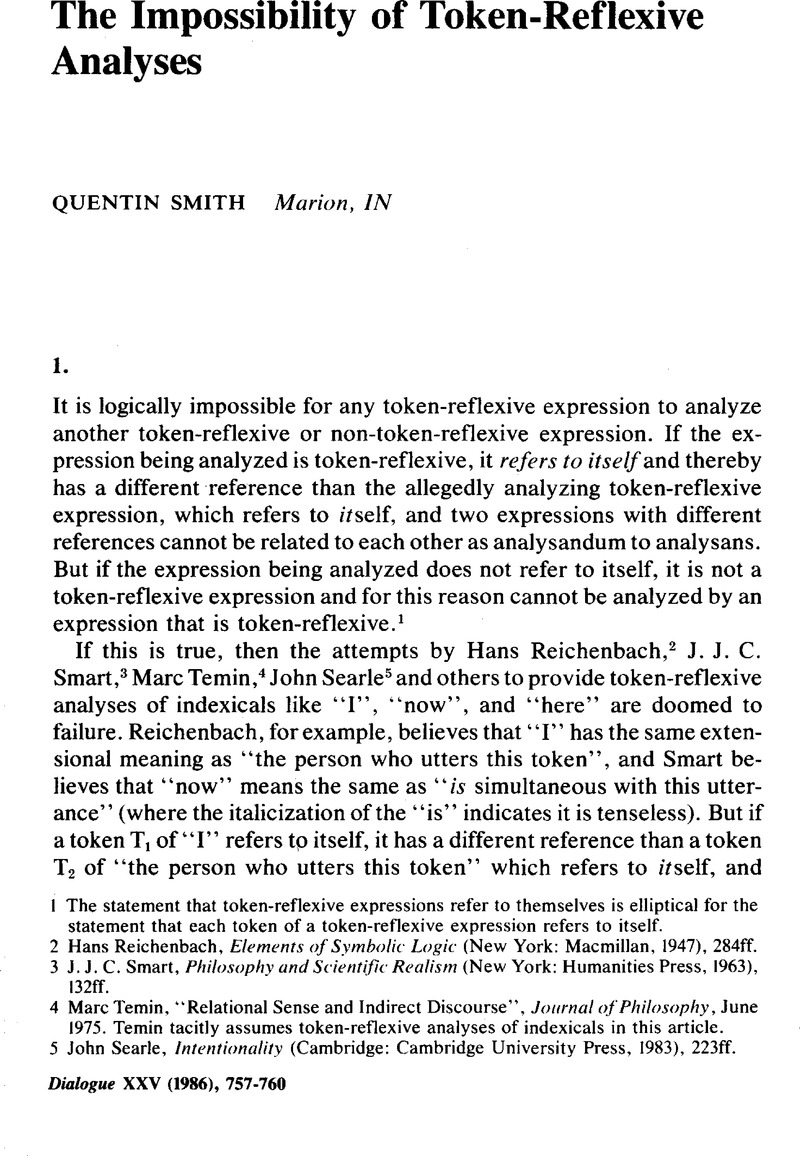Article contents
The Impossibility of Token-Reflexive Analyses
Published online by Cambridge University Press: 13 April 2010
Abstract

- Type
- Interventions
- Information
- Dialogue: Canadian Philosophical Review / Revue canadienne de philosophie , Volume 25 , Issue 4 , Winter 1986 , pp. 757 - 760
- Copyright
- Copyright © Canadian Philosophical Association 1986
References
1 The statement that token-reflexive expressions refer to themselves is elliptical for the statement that each token of a token-reflexive expression refers to itself.
2 Reichenbach, Hans, Elements of Symbolic Logic (New York: Macmillan, 1947), 284ff.Google Scholar
3 Smart, J. J. C., Philosophy and Scientific Realism (New York: Humanities Press, 1963), 132ff.Google Scholar
4 Temin, Marc, “Relational Sense and Indirect Discourse”, Journal of Philosophy, 06 1975.Google Scholar Temin tacitly assumes token-reflexive analyses of indexicals in this article.
5 Searle, John, Intentionality (Cambridge: Cambridge University Press, 1983), 223ff.CrossRefGoogle Scholar
6 John Searle's recent theory of token-reflexivity is somewhat different than Reichenbach's and Smart's. For Searle, “now” is not synonymous with or analyzed by “is simultaneous with this utterance” because the former but not the latter shows but does not state its token-reflexivity. Searle introduces “at cotemporal” as a synonym of "now"; “at cotemporal” refers to the time ofits utterance and shows but does not state its self-reference. But this revision of the traditional token-reflexive theory does not avoid the abovementioned problem. If “now” and “at cotemporal” each refers to itself then they have different extensional meanings and one cannot be synonymous with or analyze the other. And if “now” does not refer to itself it will be false to assert that it has a token-reflexive meaning that is capable of being analyzed or ex-pressed by a synonym.
7 Fitzgerald, Paul, “Nowness and the Understanding of Time”, Boston Studies in the Philosophy of Time 20, 267–268.Google Scholar
8 Schlesinger, George, Aspects of Time (Indianapolis, IN: Hackett, 1980), 132.Google Scholar
9 For further criticism of the token-reflexive theory, see Smith, Quentin, “Sentences About Time”, The Philosophical Quarterly 37 (1987), 37–53,CrossRefGoogle Scholar and “Problems with the New Tenseless Theory of Time”, Philosophical Studies, forthcoming. Also see The Felt Meanings of the World: A Metaphysics of Feeling (West Lafayette, IN: Purdue University Press, 1986), chaps. 4Google Scholar and 6, and “The Mind-Independece of Temporal Becoming”, Philosophical Studies 47 (1985), 109–119CrossRefGoogle Scholar.
- 1
- Cited by




